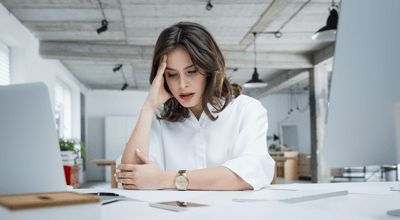October 16, 2024
 by Kayla Matthews / October 16, 2024
by Kayla Matthews / October 16, 2024

Applicants have more ways to apply for jobs than ever before.
As a result, HR departments are receiving more applications than they can handle. To handle the rise in applications, HR departments and hiring teams turn to applicant tracking systems (ATS) to scan through hundreds of resumes quickly.
An ATS is an automated system that scans resumes and filters them based on how well they match the job description. So even if a position receives thousands of applications, the hiring committee finds the most suitable candidate.
Over 98 percent of Fortune 500 companies use an ATS to filter out applicants. However, these systems can be temperamental. If you don't make your resume ATS-friendly, it will get filtered out.
This article will provide essential tips on making your resume ATS-friendly, increasing your chances of passing the initial screening, and moving one step closer to landing your dream job.
If you apply for a job at a major company, your resume is likely to be scanned by an ATS software before it is read by a human being for important information like former job titles, keywords, and education. The ATS will then create an entry for you, matching information like your phone number, email, and first and last name with a score based on how relevant your resume is to the position.
The less fit the resume looks for the position, the lower the score assigned. If it's low enough, that resume may even be excluded from the pool of applicants.
Older ATS can be very strict about the keywords they scan for; at worst, they will accept exact matches only. So, if a company is looking for someone with "keyboard skills" and you call yourself a "typist," you may appear lower on the list.
Not to mention, typos may count against you twice: once when the ATS scans your resume and again once it gets in front of a pair of eyes.
Newer ATS are more flexible and understand that exact matches aren't always the best way to find qualified applicants—just ones who know how to game the system.
There's no guaranteed way to tell what kind of ATS a company is using, and there are dozens of ATS on the market. Some major corporations still use ATS to look for exact keyword matches.
Even if your skills fit the job description, you'll need to tailor your resume to get past the ATS. Here's how to go about it:
Job descriptions often contain the keywords and position titles that the ATS is looking for.
An ATS looking to staff an administrative assistant might consider a qualified candidate who has worked as a file clerk, especially if their resume doesn't include keywords the hiring team is looking for—like "data entry," "receptionist," or "Excel."
When building your resume for a specific position, use the job description as a guide and rephrase your skills to match the description.
Your resume needs to be readable by the ATS if you want it to get in front of a human. Certain old-school resume rules – like the one-page resume rule – may be worth breaking.
An ATS generally cares more about keywords than resume length, and if your resume makes it to a member of the hiring team who would take offense at your multi-page resume, it's already part of an exclusive pool of resumes (the 25 percent that made it past the machine).
There are also many different formatting decisions that can trip up an ATS, and you'll want to be aware of as many of them as possible when writing and formatting your resume.
Design elements like tables, footers, and headers are good for structuring a resume that will be read by a human. However, they can confuse an ATS.
Opt for simpler formatting, even if it costs you space. Move information that you would normally put in a header, like certifications or language skills, down to your skills section. You should also set your margins to 1 inch on each side and align your text left.
If given a choice between a more interesting option and a more conservative one, err on the side of caution. For example, when parsing bullet points, some ATS will only properly record round bullet points. If your resume uses arrows, images, or some other kind of unconventional bullet system, the ATS system might store it as a garbled mess.
Newer applicant tracking systems are better at understanding abbreviations and shortened forms of months and years, but there's no guarantee that an ATS will properly read an abbreviated date.
If you format your months and years irregularly, as in "Aug. '14 – Aug. '17," the ATS may not properly record that you've worked at a company for three years.
If the ATS can't determine how long you've worked in a certain position, or if you don't include dates at all, the ATS may knock down your relevance or score.
Unless the job listing asks for another format, a Word document is the best file format to use when submitting a resume. An ATS cannot guarantee that it will be able to read a PDF, HTML, or Open Office document. Even if it can, it may not save your formatting.
The popularity of Word documents makes them a safe option. If you can't save your resume as a Word document, saving it as a PDF or TXT file is the next best option.
One common resume tip offered for beating an ATS suggests that you can simply create a list of all the keywords you think an ATS is after and append them to the end of your resume as white text (or text that matches the background color).
The theoretical result: The ATS scans all of those keywords, bumping up your resume in the system, and the evidence of your keyword hacking is invisible to human readers.
The problem with this advice is that, while it may get you to a human reader, it won't help your resume in getting to the next step. The ATS is programmed to look for certain keywords, but the person reading your resume is also scanning for those same keywords.
If your resume only reaches a person because you've hidden those keywords at the bottom, it likely won't succeed once it reaches human eyes.
If you're still worried about the ATS-friendliness of your resume after applying the above tips, it is possible to double-check your work. If you save your resume in plain text (or as a .txt file), you can get a good impression of how your resume looks to an ATS.
Tables, headers, and other advanced formatting will probably be broken. Depending on how your bullet points are styled, they might pull through. If some piece of information doesn't make it through to the text file, you should reformat it. Some resume writing services can also check your resume for ATS readability.
Here's a quick video that gives you actionable steps to optimize your resume for ATS.
Source: Jobscan
|
[Your Full Name] Professional Summary Professional Experience
[Job Title]
Education Volunteer Experience (Optional) |
Here are some frequently asked questions on making a resume ATS-friendly:
A. Use a simple, clean format without complex elements like tables, columns, images, or graphics. Stick to standard resume sections (e.g., professional experience, education, skills) to ensure that the ATS can easily parse the information.
A. Review the job description and pick out key terms and phrases that relate to the position’s required skills and qualifications. Incorporate these keywords naturally into your resume in the skills, experience, and professional summary sections.
No, tables and columns can confuse the ATS and lead to errors when parsing the content. Stick to single-column layouts to ensure all your information is properly read.
A. Avoid graphics, images, or charts. Refrain from using headers or footers as they may not be read. Also, avoid over-stuffing keywords unnaturally into your resume, as ATS can flag keyword stuffing.
A. Yes, an ATS-friendly resume is designed to make it past automated systems, but it will also be clean and easy for human recruiters to read. You should balance ATS optimization with clear, compelling content for both systems.
ATS is here to stay. HR departments just don't have another solution for the sheer number of applicants they receive for each position. Over time, ATS should become more advanced, and some flexibility should return to resume design.
For now, however, the best way to get your resume in front of a human is to prepare for the limitations of the software they use — even if it means designing a plainer CV.
Check out how to prepare for common behavioral interview questions once you clear the screening.
This article was originally published in 2019. It has been updated with new information.
Kayla Matthews is a technology journalist and professional development writer from Pittsburgh, PA. Her work has been featured on WIRED, The Muse, Digital Trends, and Information Age. To reach more from Kayla, please visit her blog, Productivity Bytes.
Looking for a new job is hard, but writing your resume doesn’t have to be.
 by Lauren Pope
by Lauren Pope
Well, it’s finally happened. Bitmoji’s have made their way to corporate America.
 by Lauren Pope
by Lauren Pope
Looking for a new job is hard, but writing your resume doesn’t have to be.
 by Lauren Pope
by Lauren Pope
Well, it’s finally happened. Bitmoji’s have made their way to corporate America.
 by Lauren Pope
by Lauren Pope



